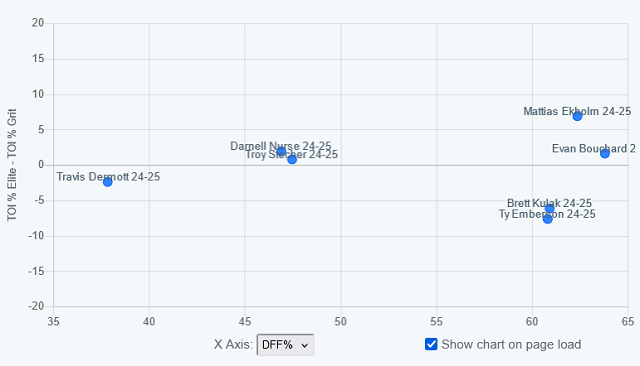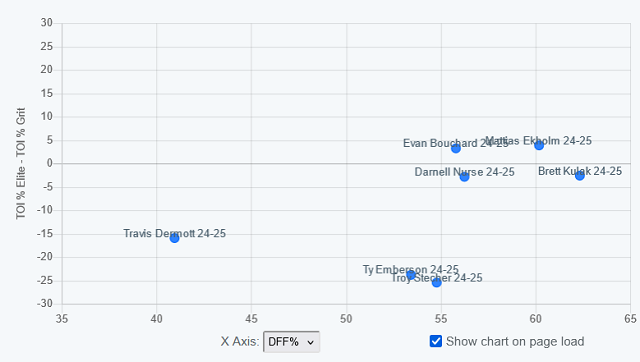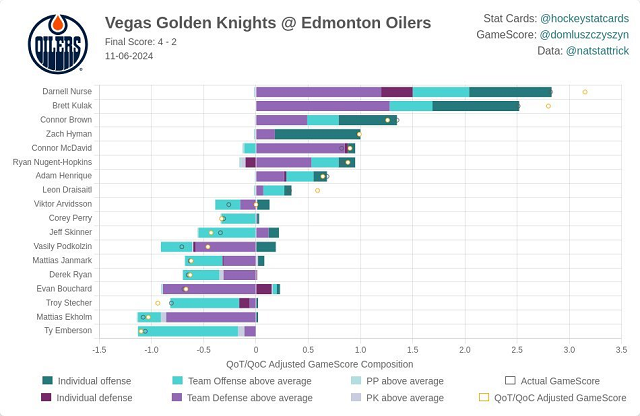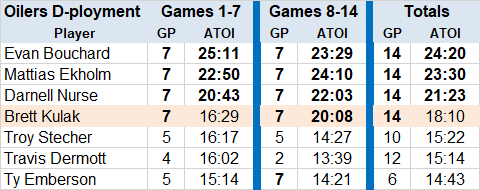Since being acquired from the Montreal Canadiens at the 2022 trade deadline, defenceman Brett Kulak has been a bastion of consistency. He watched the first game after his arrival from the pressbox behind a defence corps of Duncan Keith, Cody Ceci, Kris Russell, Tyson Barrie, Darnell Nurse and Evan Bouchard, but replaced Russell in the line-up two days later. Since then, he has played every single game for the Oilers, including 196 in the regular season and another 53 in the playoffs.
Kulak belongs to a peculiar class of Oilers rearguard that has populated the team one or even two at a time for well over a decade. Veteran mid-level guy developed elsewhere, acquired on the trade or free-agent market and ultimately signed to a four-year — always, four-year — eight-figure deal to fill a depth role best described as “#4-5 d-man”. Typically on or close to Jul 01, with much fanfare. Consider:
- Andrew Ference, signed to a four-year, $13 million UFA deal in 2013.
- Mark Fayne, signed to a four-year, $14.5 million UFA deal in 2014.
- Kris Russell, signed to a one-year UFA deal in 2016, then a four-year, $16 million extension in 2017.
- Cody Ceci, signed to a four-year, $13 million UFA deal in 2021.
- Brett Kulak, acquired by trade at the deadline in 2022, then signed to a four-year, $11 million extension that summer.
Today, only Kulak remains from the “four-year club”. The others have gone their various ways: Ference lived out his contract on LTIR, Fayne in the AHL, Russell played his out and even got a further one-year extension before retiring, Ceci was traded for value with no retention after three years of useful service.
Kulak has been a fixture at 3LD throughout that time, consistently playing about 15-18 minutes per game, the vast majority of that at even strength. Last season, for example, he played all 107 games but reached the 20-minute plateau just four times, with a high-water mark of “just” 20:49. As a general rule, 20 minutes is the dividing line between top four and bottom pair, with Kulak’s deployment the sign of a clear #5.
His principle partners in his first 2+ seasons here were Barrie (14 hours together in the regular season) and Vincent Desharnais (12 hours), both third-pairing righties with very little else in common. But both those guys are gone now, as is Ceci (6½ hours with Kulak). Bouchard remains, but after playing 4 hours with Kulak between the deadlines of ’22 and ’23, Bouch has been stapled to the right side of Mattias Ekholm on Edmonton’s first pairing. That has left Nurse to anchor the second pair and Kulak the third.
Or so was the plan until recently. With the joint departures of Ceci and Desharnais last summer along with that of swing man Philip Broberg, the Oilers had a serious reworking of their back end. Instead of the previous three players who in the current season command some $10 million in cap, replacements Ty Emberson, Troy Stecher and Travis Dermott all come in under $1 million per man and barely $2.5 mil all in.
Brett Kulak’s cap hit of $2.75 million is more than the three of them combined; judging by the current payroll structure, he “should” be #4.
It stands to reason that the native of Stony Plain, AB is starting to find an elevated role within the seven-man unit, handedness be damned. And in recent games, the Oilers coaching group has devised an innovative plan to move him up the line-up.
Earlier in the season, I wrote of the unusual 4-6-7 rotation being deployed by coaches Kris Knoblauch and Paul Coffey, in which Kulak primarily lined up with young Emberson on the third pairing while the more veteran Stecher and Dermott largely split time between the press box or playing with Nurse on the second pairing. By and large, though, the squad went with three distinct pairings in each game.
Games 1-7
The most common pairs jump off this chart, courtesy the good folks at PuckIQ.com.
Not surprisingly, the power couple of Ekholm-Bouchard stand out in the upper-right quadrant, which tells us they played the toughest competition (vertical axis) with the best flow of play (horizontal axis). Of the other pairs, Nurse-Stecher had the tougher assignments but with indifferent results on the shady side of 50%, while Kulak-Emberson played more sheltered minutes but with the puck moving north for much of that time.
Here’s how the pairings rolled from the perspective of Brett Kulak:
There’s a little bit of scramble here. In Game 1 Kulak lined up with Dermott for 40 minutes while the projected second pair of Nurse-Emberson struggled; the younger man started the third period beside Kulak, and there he has largely remained. Emberson did sit out Games 3 and 7, with Stecher drawing in beside Kulak both times. Dermott typically slotted in with Nurse when he played, with precious little success. When that duo got burned for a crucial goal against vs. Carolina in Game 7, it was back to the drawing board for the coaching staff.
Through 7 games, there had been a clear divide in ice time and responsibility between the top three of Bouchard, Ekholm and Nurse (all over 20 minutes a night) and the quartet of Kulak, Stecher, Dermott and Emberson (all in the 15-16 minute range). Kulak stood out as the only one of that group to play all the games, but otherwise his deployment within those games was third pairing all the way.
Games 8-14
A new wrinkle emerged in Game 8, when the Oilers rolled the following pairings to start the game:
- Ekholm-Bouchard
- Nurse-Kulak
- Ekholm-Bouchard
- Nurse-Stecher
- Kulak-Emberson
- Ekholm-Bouchard
The subtle change was evident on the second shift and periodically throughout the game, primarily in high-leverage situations near the beginning or end of a period or in response to a specific match-up. Nurse and Kulak had played just 5:56 together in the first 7 games combined; in Game 8 alone they were a duo for 5:58. As if an affirmation, the Oilers rolled to a 4-0 win.
That was the start of a trend that continued for 5 more games, where Nurse and Kulak played 4-7 minutes as a pairing in each, while spending the rest of their 5v5 minutes with their “other” partners. In effect, the d-corps rolled as FOUR distinct pairings:
- #1 pair (heavy minutes): Ekholm-Bouchard
- #2 pair (specialized minutes): Nurse-Kulak
- #3A pair (somewhat sheltered minutes): Nurse-Stecher (or Nurse-Dermott)
- #3B pair (more sheltered minutes): Kulak-Emberson
This innovative work-around allowed the coaching staff to give young Emberson a steady diet of third pairing minutes with the same partner in Kulak, while giving the latter additional minutes against tougher comp, asking him to switch to his off-side in the process. In effect, Kulak has been doing double duty as both a #4 and a #5 defender.
In the process, he’s been accumulating the minutes, having reached the 20-minute marker no fewer than 5 times in the last 7 games, indeed has averaged that workload over the set of games combined. That’s more 20-minute games in the last 7 than he logged last year in 107.
On average, his ice time has risen by the better part of 4 minutes per game over the last 7, with those extra minutes primarily accumulated in those selected shifts with Nurse.
Looking at the 7 games as a whole, every d-man but Dermott was on the right side of the 50% break-even line, but with a clear top four emerging in or near the upper right quadrant of the PuckIQ chart. Nurse and Kulak had slightly lesser QualComp than the top pair, but bear in mind all those relatively sheltered minutes each played with the guys near the bottom of the page. It stands to reason that the selected Nurse-Kulak minutes were against a much higher standard of comp.
In Game 14 vs. Vegas, the coaches took this experiment to the next level, using Nurse-Kulak as the second pairing for most of the game, with the occasional extra shift with their prior partner. The other wrinkle was that Stecher-Emberson were spotted in as a duo, meaning that this particular game featured FIVE “regular” pairings:
- Ekholm-Bouchard 18:07
- Nurse-Kulak 15:30
- Stecher-Emberson 6:58
- Nurse-Stecher 5:22
- Kulak-Emberson 4:55
That last partnership had been rarely seen previously, the two righties teaming up for just 10 minutes in 13 games. But against Vegas they got a bunch of shifts together.
For his part, Kulak played a monstrous 23:48 in all situations, and had a tremendous game, powered by his high-end wheels. He chipped in on 6 Grade A shots by the Oilers, an exceptional number for a d-man, especially one not involved in the powerplay. He scored his third goal of the season to tie the score, sliding into the middle slot to deflect home his partner Nurse’s point shot. By one popular metric, he and Nurse were Edmonton’s two strongest players in this game:
Alas, it came in a losing effort as Edmonton’s top pair, reliably excellent most games, had something of an off-night. But the new deployment wrinkle passed the “proof of concept” test with flying colours.
Games 1-14
Here’s TOI for the season to date, neatly divided into equal seven-game sets that define the before and after of the Nurse-Kulak experiment. The top pair continues to log about 24 minutes a night each, and plays almost exclusively as a duo at even strength. Nurse’s ice time has risen by about 1:20 per game, Kulak’s by a more substantial 3:40. The extra minutes came from the bottom three guys, who have each seen their ice time cut back by a minute or two.
The PuckIQ splits above tell us the results have been good from a flow of play perspective. The team has had a little more success, improving from 2-4-1 with a miserable -13 goal share in the first 7 GP, to 4-3-0 with -3 in the second. Still far from ideal, but better.
By all appearances the club is just trying to make the best of a less-than-ideal septet in the intermediate term with the expectation of an upgrade at or near the trade deadline. The obvious target since the beginning has been a veteran defender with top-four capability, preferably a righty. GM Stan Bowman has expressed his plan of accruing cap space to that end, and emphasized it again this week when he returned both Drake Caggiula and Noah Philp to Bakersfield to recommence the accrual process. From a cap perspective, the longer he can wait to pull the trigger, the better.
In the meantime, the coaches have been experimenting with various work-arounds to maximize their seven-man crew, and I give them full marks for the creativity they’ve shown. The key to it all has been Brett Kulak, who has taken on extra workload and responsibility in a top-four role in a growing percentage of the time. To these old eyes, he’s been doing a pretty creditable job splitting time between the second and thirds pairings and switching sides in the process. He’s been waiting a while for this opportunity and to this early point appears to be making the most of it.
Practice update
Two veterans got banged up in Wednesday’s loss to Vegas. Stecher blocked a shot late in the third, hobbled down the tunnel and did not return, but was OK to go today. Mattias Janmark on the other hand came back from a tumble into the boards to finish the game, but took a maintenance day today.
Janmark’s absence left just eleven healthy forwards, who rotated through three lines as shown. The defensive septet on the other hand remains intact, even as the listed pairings don’t fully reveal to what the coaches have been deploying in actual games.
Recently at the Cult of Hockey
LEAVINS: Player grades from frustrating loss to Vegas
STAPLES: Connor McDavid back and healthy in time for Las Vegas
McCURDY: Skinner scores, Skinner saves in narrow win.
STAPLES: Oilers special teams ace gets ripped
LEAVINS: A true test of team — 9 Things


Follow me on X-Twitter @BruceMcCurdy





